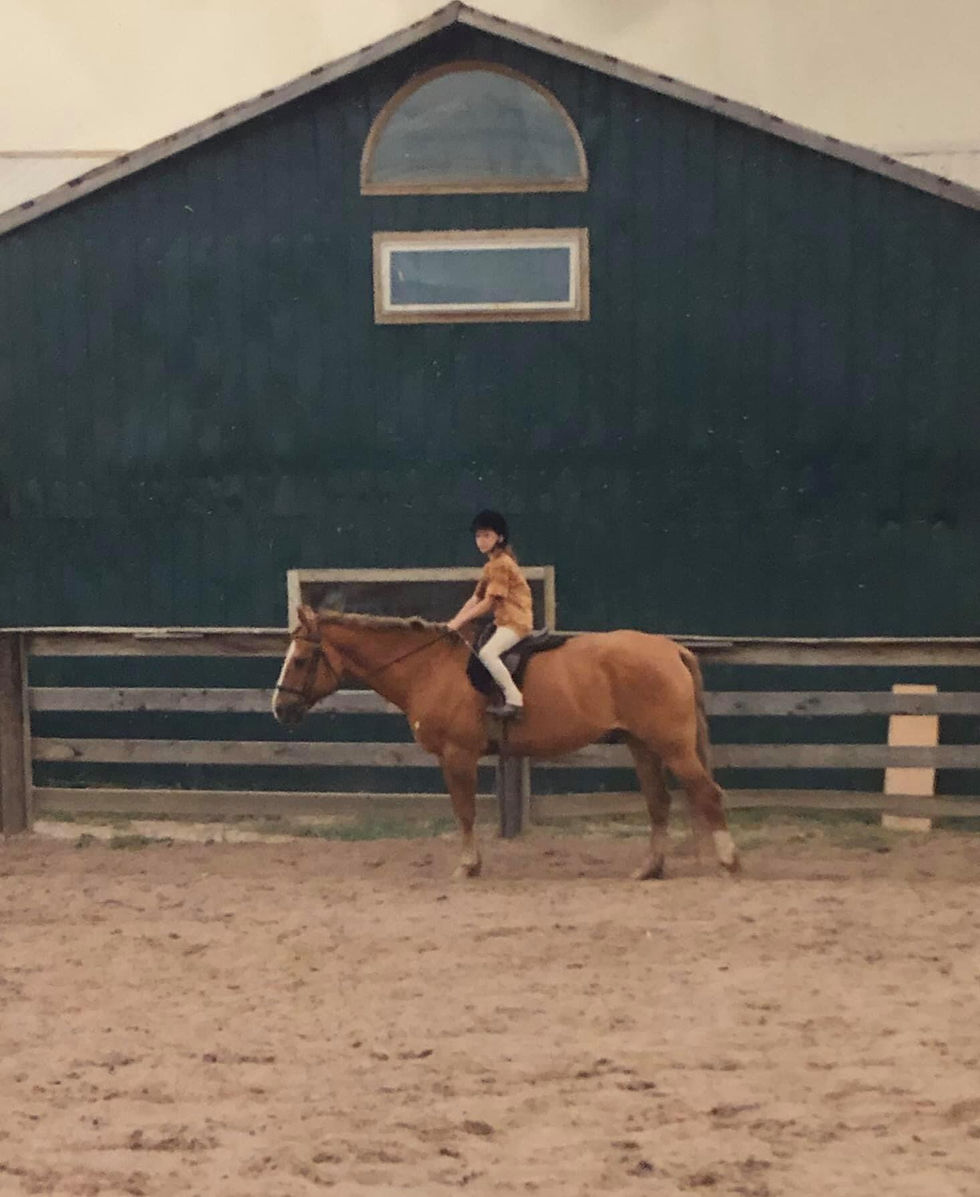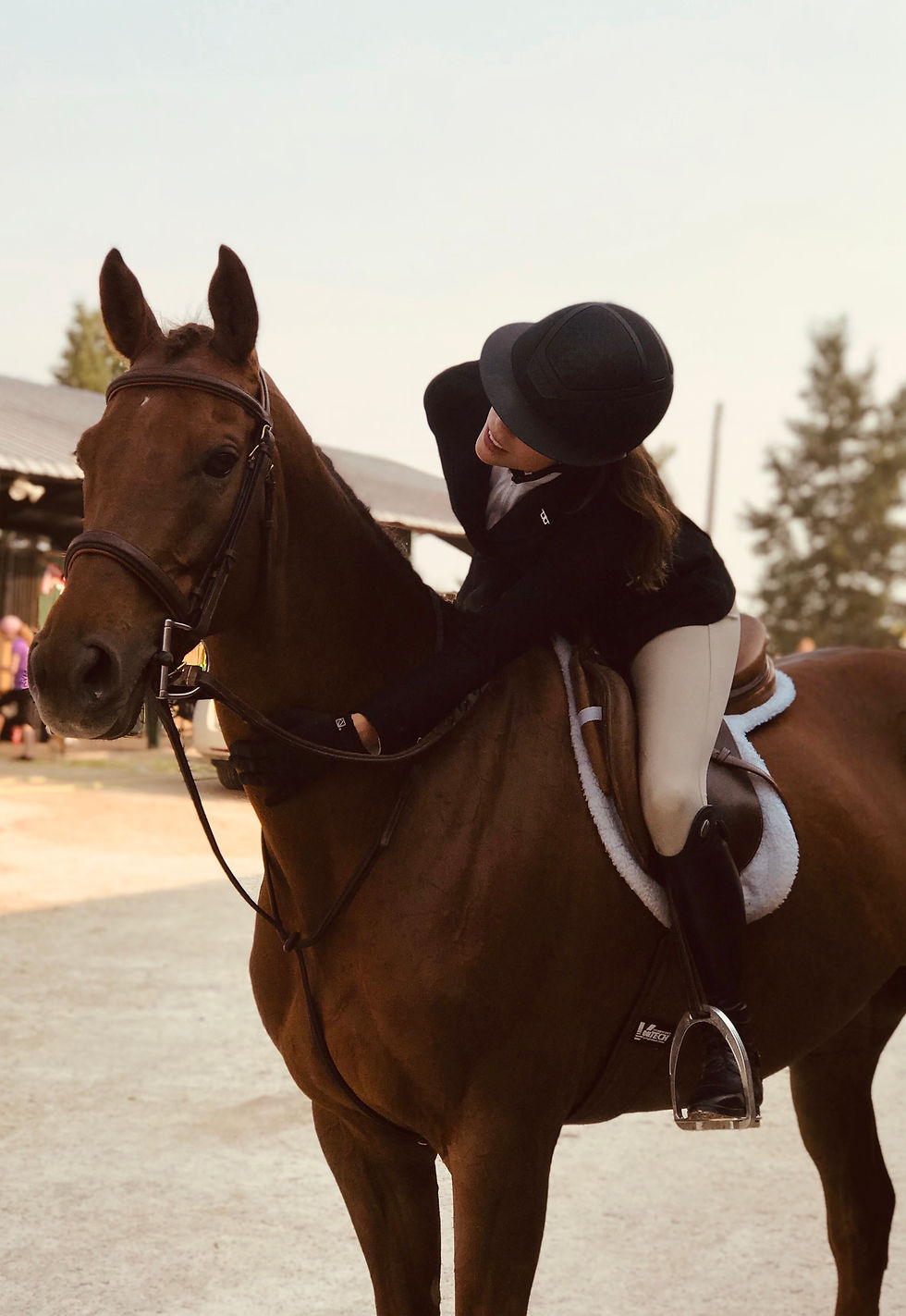The Drive
- Cate Chant

- Aug 21
- 6 min read
Updated: Aug 23

When I was nine years old, I dreamed of becoming a professional rider. I devoured every horse-related book or magazine I could find, spent my days in school drawing horses in the margins of my textbooks, and slept clutching a plush horse beneath a framed print of George Stubbs’ Whistlejacket. I lived and breathed horses. Ironic, then, that the ability to breathe escaped me as soon as I got in the car wearing jodhpurs and paddock boots and my mom merged onto the freeway heading west out of the city for my weekly riding lesson. Like clockwork, my excitement morphed into anxious trepidation as the car grew closer to the dilapidated barn where power lines criss-crossed muddy paddocks and urban sprawl was closing in on the dusty outdoor ring.
My stomach would tighten in knots as warehouses and apartment complexes outside the window gave way to patches of undeveloped green space, the prior week’s criticism from my instructor playing on a loop in my head. Your reins are too long. Your heels aren’t down. You’re on the wrong diagonal. Who’s to say now if that’s really how they phrased it. In my memory, the instructor’s sharp voice would echo through the wooden rafters of the indoor arena as they announced my shortcomings to the rest of the group lesson. I’d put all my effort into uncoordinated attempts to correct my mistakes, while the horse I was riding tried to rub my foot off on the wall or encroached on the requisite two-horse distance between us and the horse we were following. If the other students in my lesson found everything as challenging as I did, they never let on.
In spite of the vast discrepancy between my lofty aspirations and natural talent, I spent every cent of my allowance and birthday money collecting supplies for a horse I was convinced I’d one day own—a flat-seated jump saddle made in Argentina decades before I was born, a purple halter with carrots and horse shoes on the noseband, a matching set of four purple polos. These items became my prized possessions. When showjumping events at Spruce Meadows were televised, I’d pull out the sofa table from behind the couch in my basement and place my saddle across the top of it, wrapping polos around each of the table legs. Then I would carefully run down the stirrups and mount from the left side of the table, “riding” the course and practicing my two-point while the horses jumped on TV. In my dreams, I wore a velvet hunt cap and rode beautiful horses gracefully over red-and-white obstacles, earning a rainbow of satin ribbons. In reality, I was more comfortable on a tacked-up table than I was on an actual horse. Perched nervously on the back of slow-moving lesson horses, my anxiety precluded me from sitting up straight or asserting any influence over the animal beneath me.
I envied the older girls who seemed at ease in the barn, whose horses resided in deeply-bedded box stalls in a separate aisle and diligently raised their legs for their owners to pick out their hooves. In the dimly lit aisle where the school horses waited to be tacked up in standing stalls, I struggled to pick out their feet or tighten the girth without getting squished against the wall. I was undersized, pale and socially awkward, and it was apparent that even the horses knew I had no leverage over them. Outside of the barn, my obsession with all things equestrian served mostly to ostracize me from my classmates, the majority of whom had better social skills and other interests in common. At recess, I’d sit alone studying the Encyclopedia of Horses, memorizing parts of the horse and different pieces of tack. The gulf between my theoretical knowledge of horses and my actual ability to ride them felt endless and at times unsurmountable.
Of all the impediments to becoming a professional showjumper, the most glaring was my debilitating fear of cantering. Despite small improvements over time in my posture and steering, the prospect of a gait that was faster, more powerful, and seemingly well beyond my control made my body freeze in terror while tears welled in my eyes. I owe overcoming that hurdle to the generous instructor who eventually allowed me trot a crossrail on a saintly lesson horse, Topper, knowing he’d likely land at the canter and force me to face my fears. Nearly 30 years old, arthritic and blind in one eye, Topper lifted his front legs as I buried my hands in his mane at the base of the jump, slowly cantering away on the landing side and giving me the grace to believe that cantering was within my abilities. Those first canter steps courtesy of a kind old horse revealed untapped potential within myself and opened the door to riding more animated horses, jumping small courses, and attending local schooling shows.
When I moved on from the lesson barn, I graduated to an A circuit program where I began competing in the children’s hunters. On the drive to the barn, I’d practice finding distances to telephone poles, counting imaginary strides between the light posts that lined the highway. I learned new skills and developed the ability to ride greener, scopier horses, moving up and accomplishing a goal of competing in the “big eq” in my final junior year. My anxiety never left me, but remained a constant companion, hovering over my shoulder on the course walk at the horse show and whispering doubts in the back of my mind whenever a coach set an oxer higher and wider in a lesson. Over time, I learned to quiet that voice and lean into nervousness, accepting that competence comes from doing something over and over again until it eventually comes to you easily.
I’ve learned countless lessons from horses who’ve kept me accountable, teaching me over the years when to dig in, when to take a step back, how to assert myself calmly and how to summon the courage to jump bigger fences. Horses have asked for clarity when I’ve given them confusing cues, have given me forgiveness when I’ve tried to add or leave out a stride beyond reason, and have offered clues when they were unhappy with the way the bit felt against their tongue or how the saddle sat on their back. Like riders, every horse has their own strengths and weaknesses, presenting puzzles that are best solved with knowledge, empathy, and an open mind. Horses selflessly help us pursue our goals and convey their own feelings of stress, fear, pain and excitement all without words, counting on us as their partners to seek to understand them. With guidance from some talented coaches and that childhood drive to learn as much as possible, I’ve never given up on chasing a once-distant dream on the back of these highly sensitive creatures.
I turned professional in 2018, but still remember vividly how it felt to be a lesson kid wanting nothing more than to be around horses. I’ve been fortunate to learn from several great horsemen, and can recall moments when others made me feel like my ambitions were beyond my capabilities. As a professional, I try to always teach others with kindness, remembering the times insecurity and inexperience made my own goals feel impossible. I owe credit to the coaches who have helped me believe in myself, who have stood at the ingate and said “you know what you’re doing, you’ve got this,” whose frank assessments of my riding have improved my communication with my horses, and who have reminded me in the times I felt like I was struggling that I don’t always give myself enough credit. But more than anything I’ve learned from a trainer, the greatest lessons have come from the horses themselves.
Patience, confidence, humility, empathy, balance, strength, and resilience are among the many qualities horses ask us to possess as their stewards and leaders. The intangible “feel” that makes someone a great rider is a product of untold hours of learning and practice. It requires understanding the mechanics of both the animal and the equipment and above all else, listening carefully to the horse to develop a nuanced language between horse and rider that at times overrules the instincts of both. I am a firm believer that you get what you put into this sport, and that those who want only to be around horses and learn as much as possible from them will always find meaning in a world where success can feel fleeting and out of reach. When I turn on the lights in the barn each morning and toss flakes of hay to my horses, I am reminded that my life is a dream come alive from the pages of the books I read as a child, one made true by all of the horses who have allowed me the audacity to believe that I could achieve my dreams.







Comments